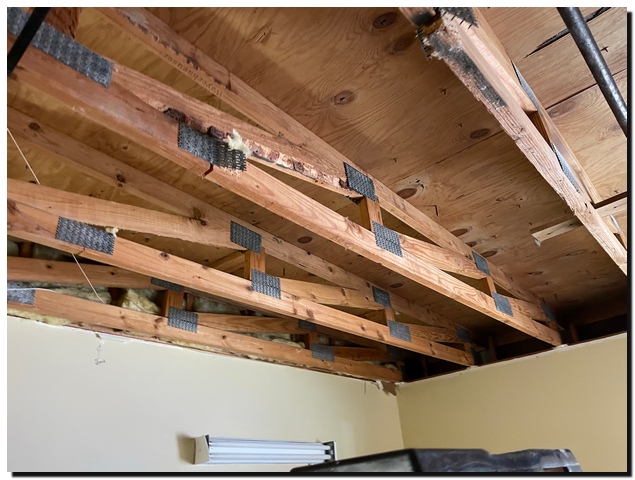Called out today to investigate a sagging ceiling in a skilled nursing home. Roofing company apparently placed several rolls of TPO material on the roof. These rolls weight approximately 400 lbs each.






Called out today to investigate a sagging ceiling in a skilled nursing home. Roofing company apparently placed several rolls of TPO material on the roof. These rolls weight approximately 400 lbs each.






I can’t believe that a 400# roll did that damage to those trusses.
Looks like an expensive repair for someone.
Marcel, they stacked several rolls
I agree Marcel, BUT…
That video someone posted awhile back of the guy dropping shingle bundles off his shoulder until the deck collapsed comes to mind.
The nails/fasteners in the Tie plate appear perpendicular the plate. One might expect the fasteners to be angled due to shear force, or the surface or to a planar cross section of a body from the load above.
As well the lower chord and web is stained.
Indeed. If the damage were due to a vertical load you would expect the nails to be bent upward or downward due to shearing. The nails appear to be perfectly straight(?) In one or more of the pictures it looks more like a member came loose due to a horizontal load, pulling the gang nail (truss plate) directly out from the adjoining rafter. If I had to guess, I would say that something struck (or applied extreme pressure to) the entire roof surface horizontally (perhaps a crane) and that these truss joints were the weakest link.
Morning, Brain. Hope to find you well and in good spirits today.
Thank you for chiming in.
Where the plates are not secured the lower truss chords are spliced. To say the plates “came loose due to a horizontal load” I would completely agree with. Lateral or somewhat diagonal live loading but not vertical loading. The nailing plates are to provide strength in the horizontal tension direction.
One may argue, there are various roof truss defects. Possibly caused from rough handling of the roof construction during assembly., poor on site storage practices, to a crane operator slinging the roof trusses on a windy day.
Thoughts Brain, Randy, anyone?
Morning, Randy.
The TPO image you posted is a 5’ foot roll. 5’ x 100’ (162 lbs.)
I thought about poor onsite storage as a possibility, since there seams to be a pattern. However, wouldn’t that have been discovered a long time ago?
There appears to be a repair. The metal strapping. It appears to be a support to prevent truss rotation.
The separation at the splices is consistent with extreme tension, which could have resulted from a load above.
Ponding water and pallets of rolled material are two good possibilities.
A 20,000 sq building TPO material would weigh as much as 6,000 to 7,000 pounds. One would hope this load would have been distributed evenly during delivery, but people suck.
Hmm. Why are the nails straight then? If they failed due to tension would you not expect to see at least some of the nails bent in the longitudinal direction? And, frankly, if there was 6,000 to 7,000 lbs in only one section of the roof, after the splices failed, would you not expect a cascading failure leading to a roof collapse? In your scenario, I would have at least expected a bunch more damage.
All good points. I am not sure if the nails will bend or if the wood will just soften until release.
This appears to be a similar design.
The times I’ve seen broken trusses with loose plates like that the nails or points have always been pretty straight. I think the wood gives away before the metal will bend. Heck if it didn’t the roller press rigs that install the plates in the factory wouldn’t work.
I can imagine a pallet of roofing materials being set on a roof and causing damage in one place, but not being enough of a load to cause cascading failures and total collapse. The load breaks the trusses under it because at first they alone carry nearly all the weight. But once they pop and the structure sags down a bit that load is dispersed across more of the roof structure and spreads out enough that the failure stops. I feel like I’ve visually seen something like this before but can’t think of where and I could be totally wrong. (Which is why I’m not an engineer)
Hmm. If the wood gave out first, would we not see deep scratches / gouging of the wood itself as the nails were yanked out longitudinally? If the roof structure sagged down at that point due to a concentrated load, would we not see at least some damage to other nearby truss members and especially to the sheathing itself?
The overall footprint of the building was 40,000sf. The truss damage was confined to one side where the roofer had access to unload material (red rectangle). The red rectangle in the attached Google photo is where 10 rooms had visible sagging ceilings. The red shaded area is where my photos were taken. This room was a storage room, and the ceiling drywall could be taken down.
History helps a lot if witnesses were observing the roof materials.
Just an observation, this discolored area may be evidence of ponding.

If TPO rolls caused that kind of damage, what would a 3 or 4 foot heavy snow load do?
Thank you for the clarification Randy.